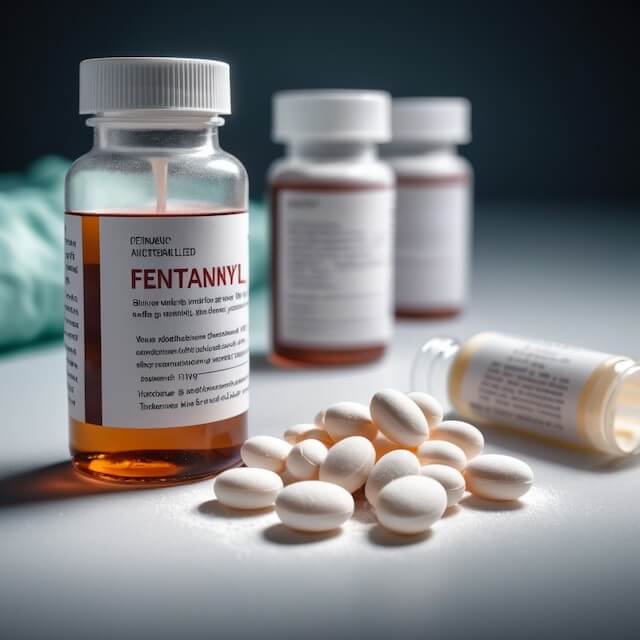The ongoing opioid public health crisis was further exacerbated by the COVID-19 pandemic. In Canada, 5,148 apparent opioid toxicity deaths occurred between April 2020 and December 2020, representing an 89% increase from the same period in 2019. Similarly, in Australia, rates of self-reported non-fatal heroin overdose among those who regularly use stimulant drugs and regularly inject drugs are also escalating. Both countries have historically faced similar challenges in combating the opioid epidemic.
Pharmaceutical fentanyl is a synthetic opioid approved for treating severe pain, typically advanced cancer pain. It is 50 to 100 times more potent than morphine. It is prescribed in the form of transdermal patches or lozenges and can be diverted for misuse and abuse in the United States. However, most recent cases of fentanyl-related harm, overdose, and death in the U.S. are linked to illegally made fentanyl. It is sold through illegal drug markets for its heroin-like effect. It is often mixed with heroin and/or cocaine as a combination product, with or without the user’s knowledge, to increase its euphoric effects.

Australia’s experience with extra-medical opioid use differs from the Canadian experience in the patterns of drug use, trends, illicit markets, and strong border controls. Due to the lower cost of prescription opioids, heroin, and methamphetamine in Australia, this is not a driver for the need to source cheaper alternatives such as fentanyl, as is in Canada. Regardless, there remain serious concerns that Australia is mirroring the same pathway that has contributed to the opioid crisis in Canada. The number of unintentional drug-induced deaths involving opioids has nearly tripled in the last 14 years, with the crisis being primarily driven by pharmaceutical prescribing. Simultaneously, since 2012, the number of deaths involving heroin has also increased by over 65%.
This rise in fentanyl has had a devastating impact on drug therapy systems worldwide, and Victoria is no exception. Fentanyl, a powerful synthetic opioid, is up to 100 times more potent than morphine, making it extremely dangerous and highly addictive. Its prevalence on the streets has led to an alarming increase in overdose deaths, stretching healthcare resources to their limits.

Fentanyl’s potency and ease of production have made it a popular choice for drug dealers, who often mix it with other substances to increase their profits. This has led to a significant increase in unintentional overdoses, as users may not be aware that they are consuming fentanyl. As a result, the demand for addiction treatment has skyrocketed, overwhelming an already strained drug therapy system.
The impact of fentanyl on the drug therapy system cannot be overstated. The current system was not designed to handle the unique challenges posed by this synthetic opioid. Without immediate intervention, the situation will continue to deteriorate, putting more lives at risk. It is crucial that Victoria take proactive measures to fortify its drug therapy system and provide the necessary support for those struggling with addiction.

Current challenges faced by the drug treatment system in Victoria
Victoria’s drug treatment system is facing numerous challenges that hinder its ability to effectively respond to the fentanyl crisis. One of the main challenges is the lack of treatment centres and resources available to those seeking help. The demand for addiction treatment far outweighs the capacity of existing facilities, resulting in long waiting lists and delays in receiving critical care.
Another challenge is the stigma associated with addiction, which often prevents individuals from seeking help. Many people fear judgement and social repercussions, leading them to suffer in silence rather than reaching out for support. This stigma also affects healthcare professionals, who may not have the necessary training or knowledge to effectively treat addiction.
Additionally, the drug therapy system in Victoria lacks coordination and collaboration between healthcare providers and community organisations. This fragmentation leads to inefficiencies and gaps in care, making it difficult for individuals to navigate the system and access the help they need. Without a cohesive approach, the drug therapy system will continue to struggle to provide comprehensive and effective addiction treatment.

Health experts' recommendations for preparing the drug treatment system
Health experts agree that urgent action is needed to strengthen Victoria’s drug treatment system and prepare for the influx of fentanyl. These recommendations aim to address the current challenges and ensure that individuals struggling with addiction receive the support and resources they need.
- Strengthening addiction treatment services: Increasing the capacity of treatment centres and hiring more addiction specialists is crucial to meet the growing demand for care. This includes expanding both inpatient and outpatient services to accommodate individuals at different stages of their recovery journey.
- Increasing access to harm reduction programs: Harm reduction initiatives such as supervised consumption sites, needle exchange programs, and overdose prevention training can help mitigate the risks associated with fentanyl use. By providing safe spaces and resources, individuals are more likely to engage with the healthcare system and access addiction treatment services.
- Educating healthcare professionals on fentanyl-related issues: Training healthcare professionals on the unique challenges posed by fentanyl is essential to ensure effective treatment and support. This includes understanding the signs of fentanyl overdose, appropriate prescribing practices, and the use of naloxone, a medication that can reverse opioid overdoses.
- Collaborating with community organisations: Strengthening partnerships between healthcare providers and community organisations can help bridge the gaps in care and provide holistic support to individuals struggling with addiction. These partnerships can facilitate referrals, provide additional resources, and offer support services beyond medical treatment.

Government initiatives to support the drug treatment system
The government plays a crucial role in supporting and strengthening Victoria’s drug therapy system. Recognising the urgency of the fentanyl crisis, the government must take proactive measures to ensure the system can adequately respond to the growing demand for addiction treatment.
- Increased funding: Allocating additional funding to the drug therapy system is essential to expand treatment capacity, hiring more addiction specialists, and improving access to harm reduction programs. This investment will help alleviate the strain on healthcare resources and ensure individuals receive timely and appropriate care.
- Policy changes: Implementing policies that prioritise addiction treatment and remove barriers to care is essential. This includes reducing stigma, improving reimbursement rates for addiction services, and integrating addiction treatment into mainstream healthcare systems. By integrating addiction treatment into the existing healthcare infrastructure, individuals will have better access to comprehensive care.
- Public awareness campaigns: Raising public awareness about the dangers of fentanyl and the availability of addiction treatment services is crucial to combat stigma and encourage help-seeking behaviour. Public campaigns can educate the community on the signs of overdose, how to respond in an emergency, and the importance of seeking professional help.

The fentanyl crisis is a pressing public health issue that demands immediate attention. Victoria’s drug therapy system is on the verge of collapse, and urgent action is needed to prevent further loss of life. By understanding the impact of fentanyl, addressing current challenges, and implementing the recommendations put forth by health experts, Victoria can strengthen its drug therapy system and provide the necessary support for those struggling with addiction.
It is crucial for the government, healthcare providers, and community organisations to work together to ensure a coordinated and holistic approach to addiction treatment. Increased funding, policy changes, and public awareness campaigns are key components of a comprehensive strategy to combat the fentanyl crisis.
The time for action is now. Lives are at stake, and it is our collective responsibility to fortify Victoria’s drug therapy system, provide the necessary resources, and save lives. Together, we can confront the challenges posed by fentanyl and offer hope and healing to those affected by addiction.

